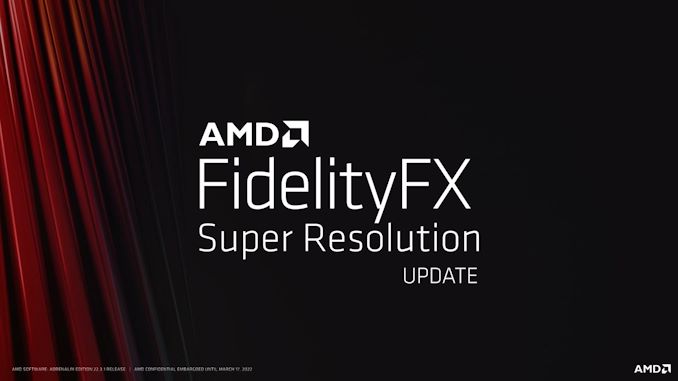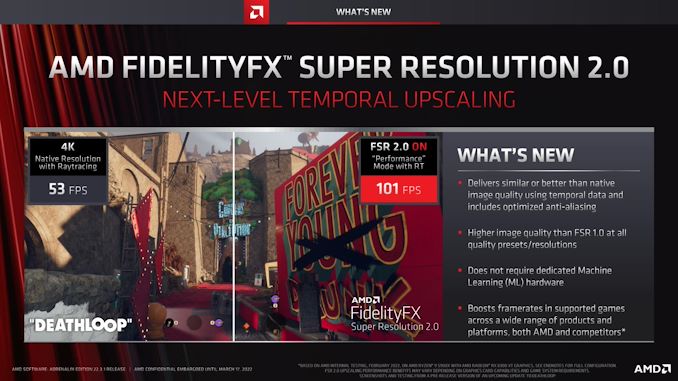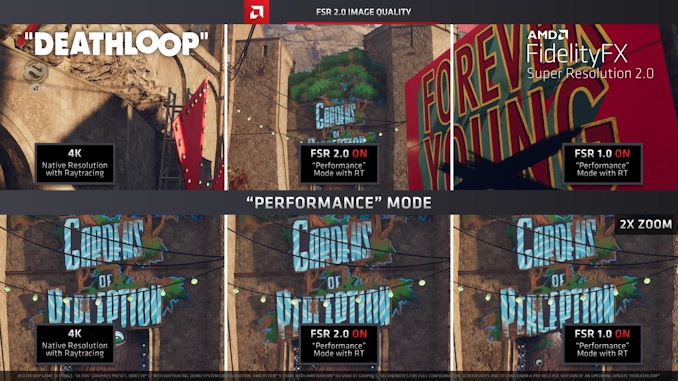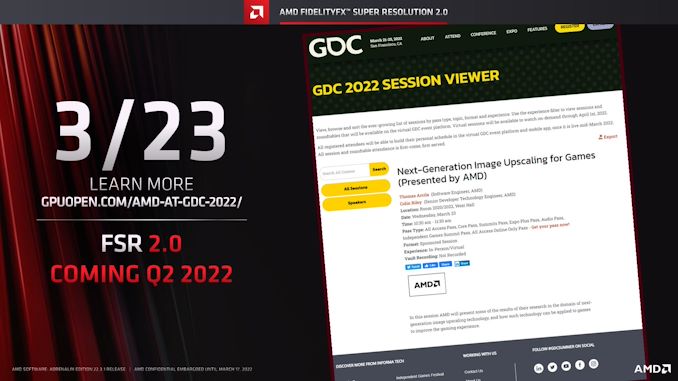AMD Teases FSR 2.0: Temporal Upscaling Tech for Games Coming in Q2
by Ryan Smith on March 17, 2022 9:01 AM EST
Alongside their spring driver update, AMD this morning is also unveiling the first nugget of information about the next generation of their FidelityFX Super Resolution (FSR) technology. Dubbed FSR 2.0, the next generation of AMD’s upscaling technology will be taking the logical leap into adding temporal data, giving FSR more data to work with, and thus improving its ability to generate details. And, while AMD is being coy with details for today’s early teaser, at a high level this technology should put AMD much closer to competing with NVIDIA’s temporal-based DLSS 2.0 upscaling technology, as well as Intel’s forthcoming XeSS upscaling tech.
AMD’s current version of FSR, which is now being referred to as FSR 1.0, was released last summer by the company. Implemented as a compute shader, FSR 1.0 was a (relatively) simple spatial upscaler, which could only use data from the current frame for generating a higher resolution frame. Spatial upscaling’s simplicity is great for compatibility (see: today’s RSR announcement) but it’s limited by the data it has access to, allowing for more advanced multi-frame techniques to generate more detailed images. For that reason, AMD has been very careful with their image quality claims for FSR 1.0, treating it more like a supplement to other upscaling methods than a rival to NVIDIA’s class-leading DLSS 2.0.
However it’s been clear from the start that if AMD wanted to truly go toe-to-toe with NVIDIA’s upscaling technology that they’d need to develop their own temporal-base upscaling tech, and that’s exactly what AMD is doing. Set to launch in Q2 (Computex, anyone?), AMD is developing and will be releasing a new generation of FSR that incorporates both spatial and temporal data for more detailed images.
Given that FSR 2.0 is an AMD technology, the company isn’t really beating around the bush here as to why they’re doing it: using temporal data allows for higher quality images. And while it goes beyond the scope of today’s teaser from AMD, like DLSS (and XeSS), they are clearly going to be relying on motion vectors as the heart of their temporal data. This means that, like DLSS/XeSS, developers will need to build FSR 2.0 into their engines in order to provide FSR with the necessary motion vector data. Which is a notable trade-off from the free-wheeling FSR 1.0, but is none the less a good trade-off to make if it can produce better upscaled images.
And although FSR 2.0 won’t launch for a few months, AMD is already taking some efforts to underscore how it will be different from DLSS 2.0. In particular, AMD’s technique does not require machine learning hardware (e.g tensor/matrix cores) on the rendering GPU. Which is especially important for AMD, since they don’t have that kind of hardware on RDNA 2 GPUs. As a result, conceptually, FSR 2.0 can be used on a much wider array of hardware, including older AMD GPUs and rival GPUs, a sharp departure from DLSS 2.0’s NVIDIA-only compatibility.
Though even if AMD doesn’t require dedicated ML hardware in client GPUs, this doesn’t mean they aren’t using ML as part of the upscaling process. To be sure, as temporal AA/upscaling has been the subject of research in games for over a decade now, there are multiple temporal-style methods that don’t rely on ML. At the same time, however, the image quality benefits of using a neural network have proven to be significant, which is why both DLSS and XeSS incorporate neural networks. So at this point I would be more surprised if AMD didn’t use one.
If AMD is using a neural network, then at a high level this sounds quite similar to Intel’s universal version of XeSS, which runs inference on a neural net as a pixel shader, making heavy use of the DP4a instruction to get the necessary performance. These days DP4a support is found in the past few generations of discrete GPUs, making its presence near-ubiquitous. And while DP4a doesn’t offer the kind of performance that dedicated ML hardware does – or the same range of precisions, for that matter – it’s a faster way to do math that’s still good enough to enable temporal upscaling and improve on FSR 1.0’s image quality.
Update: According to a report from Computerbase.de, AMD has confirmed to the news site that they are not using any kind of neural network. So it seems AMD is indeed going with a purely non-ML (and DP4a-free) temporal upscaling implementation. Color me surprised.
As for licensing, AMD is also confimring today that FSR 2.0 will be released as an open source project on their GPUOpen portal, similiar to how FSR 1.0 was released last year. So developers will have full access to the source code for the image upscaling technology, to implement and modify as they see fit.
Finally, as part of AMD’s teaser the company has released a set of PNG screenshots of Deathloop rendered with both FSR 1.0 and an early version of FSR 2.0. Though early screenshots should always be taken with a grain of salt – they’ve been cherry-picked for a reason – the difference between FSR 1.0 and FSR 2.0 in performance mode is easy enough to pick up on.
Meanwhile the difference versus native is less clear (which is the idea), though it should be noted that even native 4K is already running temporal AA here.
Native (4K) vs. FSR 2.0
Ultimately, today’s announcement is a teaser for more information to come. At next week’s GDC, AMD will be hosting a session on the 23rd called “Next-Generation Image Upscaling for Games”, where AMD will be presenting their research into image upscaling in a developer-oriented context. According to AMD we should expect a little more technical information from that session, while the full details of the technology will be something AMD holds on to until closer to its launch.
If all goes according to plan, FSR 2.0 will launch next quarter.




















46 Comments
View All Comments
Spunjji - Monday, March 21, 2022 - link
In spite of its deficiencies it is objectively one of the best value-for-money GPUs out there right now - if you have the right system to put it in. RSR will probably help it out a fair bit, too.Bit weird to talk of the 6500 XT right after Fiji though. Not exactly comparable classes of GPU...
mode_13h - Monday, March 28, 2022 - link
> Not exactly comparable classes of GPU...And not even comparably priced! 6500 XT has been pretty consistently going for ~$250, since launch. The cheapest Fiji (aka Fury) card launched at about double the price.
brucethemoose - Thursday, March 17, 2022 - link
"There are multiple temporal-style methods that don’t rely on ML"Not for upscaling as far as I know... for AA, perhaps, but the benefit of that so far seems to be questionable as well.
"So at this point I would be more surprised if AMD didn’t use one."
I have mixed feelings on this as well. Any kind of shader-based neural net, even a simple/primitive one, just seems like it would have a huge performance hit, especially on weaker GPUs that really need it.
I hope I'm wrong though, as a really fast, shader based network that uses multiple frames + motion vectors would be cool.
The good results in that screenshot are not impossible to get without a network, especially if the native output was already blurred by the AA.
Yojimbo - Thursday, March 17, 2022 - link
From my recollection of the things said to the run-up of the release of FSR (1.0) I think FSR 2.0 is what AMD hoped it could release back then, but they just didn't get it ready in time. Because despite what media sites claimed when the original FSR was released, AMD did indicate that FSR was a DLSS competitor by the things they said in interviews and by the fact that they never knocked back at the rampant media reports treating FSR as a DLSS competitor. Of course their PR people were aware of what the impression of the upcoming release was out in the wild and they allowed that impression to persist even though it was completely inaccurate to FSR (1.0).Regarding FSR 2.0, it's not going to be as easy to add to games as FSR 1.0. We'll have to see how much support it gets in addition to how good it is, of course).
Khanan - Friday, March 18, 2022 - link
It will probably be as hard to add to games as DLSS, but with universal GPU support aside from ancient ones, it should be well adopted.Yojimbo - Friday, March 18, 2022 - link
I'm not so sure. Will they add it just to support 10 series owners who will most likely soon upgrade? After that there will be a certain number of 16 series owners that won't upgrade in the next year. Thirdly you have 400, 500, 5000, and 6000 series owners, but all that adds up to about 6% of the steam survey, less than the 2060 + 2060 SUPER share on steam. (As a comparison, right now 16 series accounts for between 15% and 16% of the survey, and many of those can be expected to upgrade in the next year.)Also, I'd imagine that the 400 and 500 series cards, which account for over 2/3 (>4%) of that ~6%, are not good candidates for upscaling newer games. These technologies don't upscale to 1080p as well as they upscale to higher resolutions. I don't think 400 or 500 series cards are going to be upscaling new games to 4K. The 6000 series has had extremely small market penetration.
If they add FSR 2.0 it could end up being because it's from AMD and they don't want to give the impression that are leaving AMD owners out in the cold. If they are already adding DLSS it might not be that hard to also add FSR 2.0. But look towards the actual market share they address with FSR 2.0, they don't address a whole lot by adding it on top of DLSS. It's likely they know that in the future AMD will have matrix engines on their GPUs and that AMD will support XeSS on those cards. I don't know what sort of shape XeSS is in or how much the big developers know about its shape, but supporting FSR 2.0 on top of DLSS seems like it addresses a currently small and very-soon-to-be-dwindling market.
Oxford Guy - Friday, March 18, 2022 - link
‘AMD and they don't want to give the impression that are leaving AMD owners out in the cold.’AMD had the nerve to dump Fiji owners by the side of the road way back in July. It is safe to say that the current management isn’t very concerned about mindshare in terms of support terms.
Of course, the tech press barely covered it then and has completely buried the story since, despite the glaring connections to the 6500 XT.
vlad42 - Friday, March 18, 2022 - link
Yeah, how dare they move a 7 year old GPU to the legacy drive stack... \sOxford Guy - Monday, March 21, 2022 - link
How dare they release a card with worse performance whilst dropping driver support for a better one in the midst of history's worst GPU shortage.If your car is older than 5 years send it to the junkyard and buy an inferior new one. That's 'modern'.
Oxford Guy - Monday, March 21, 2022 - link
Fiji was being sold in 2017. AMD dropped Fiji driver support in about halfway through 2021.So much for your 7-year period excuse.